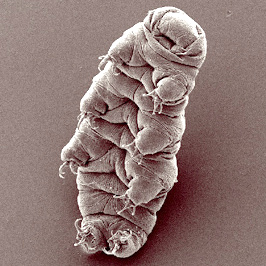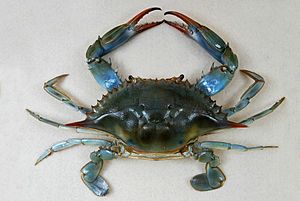Tactopoda facts for kids
Quick facts for kids Tactopoda |
|
|---|---|
 |
|
| The tardigrade Hypsibius dujardini | |
 |
|
| The blue crab Callinectes sapidus, an arthropod | |
| Scientific classification |
|
| Kingdom: | Animalia |
| Clade: | ParaHoxozoa |
| Clade: | Bilateria |
| Clade: | Nephrozoa |
| (unranked): | Protostomia |
| Superphylum: | Ecdysozoa |
| (unranked): | Panarthropoda |
| (unranked): | Tactopoda Budd, 2001 |
Tactopods are a group of animals that scientists believe are closely related. This group, also known as Tactopoda, includes two very important types of creatures: arthropods and tardigrades. Scientists group them together because they share some special features, especially how they grow and develop. Many studies support the idea that these animals belong in the same family tree.
Contents
What are Tactopods?
Tactopods are part of a larger group of animals called ecdysozoans. Ecdysozoans are animals that grow by shedding their outer skin or shell, a process called molting. Think of a snake shedding its skin or a crab growing out of its old shell. This molting process is one of the key things that links tactopods together.
Main Groups of Tactopods
The Tactopoda group includes two major types of animals:
Arthropods
Arthropods are an incredibly diverse and successful group of animals. They include:
- Insects (like butterflies and ants)
- Spiders and scorpions (arachnids)
- Crabs, lobsters, and shrimp (crustaceans)
- Millipedes and centipedes
Arthropods are known for their hard outer shell (exoskeleton) and their jointed legs. They are the largest group of animals on Earth, found in almost every habitat.
Tardigrades
Tardigrades are tiny, fascinating creatures often called "water bears" or "moss piglets." They are usually less than a millimeter long. What makes tardigrades so special is their amazing ability to survive extreme conditions. They can live through:
- Very hot or very cold temperatures
- High levels of radiation
- The vacuum of space
- Years without food or water
They do this by going into a special state called cryptobiosis, where they dry out and become like a tiny, tough ball.
Why are they Grouped Together?
Scientists group arthropods and tardigrades into Tactopoda because they share several unique features. These include:
- Molting: Both groups shed their outer layer as they grow.
- Similar Body Plans: Even though they look very different, their basic body structures and how they develop from an embryo show similarities.
- Nervous System: There are also similarities in how their nervous systems are organized.
Studying Tactopoda helps scientists understand how these amazing animals evolved and how they are related to each other on the tree of life.
See also
 In Spanish: Tactopoda para niños
In Spanish: Tactopoda para niños

